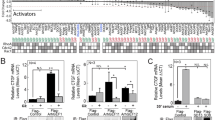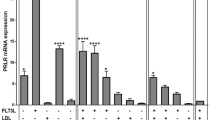Abstract
Stimulation of resting W53 cells (lymphoid murine cells expressing prolactin (PRL) receptor) by PRL induced expression of growth-related immediate-early genes (IEG), and proliferation through activation of the Src kinases. Since IEG are essential for cell cycle progression, we have studied how PRL controls expression of c-Myc mRNA and c-Fos. Stimulation of W53 cell proliferation by PRL required activation of MAPK, as the Mek1/2 inhibitor PD184352 eliminated Erk1/2 stimulation, cell proliferation, and expression of c-Fos mRNA. In contrast, PD184352 did not alter PRL activation of c-Myc mRNA expression or stimulation of p70S6K, Akt, and the Jak2/Stat5 pathway. Activation of the PI3K by PRL was necessary for the expression of c-MycmRNA and W53 cell proliferation, as the PI3K inhibitor LY294002 abolished them. However, it did not modify PRL stimulation of c-Fos mRNA expression or activation of Erk1/2 and Stat5. Furthermore, rapamycin, an inhibitor of mTOR and consequently of p70S6K, did not alter PRL stimulation of c-Myc and c-Fos mRNA expression and it had a very minor inhibitory effect on PRL stimulation of W53 cell proliferation. In addition, rapamycin did not affect PRL stimulation of Akt or Stat5. However, it reinforced PRL activation of Erk1/2. Overexpression of a constitutively activated Akt (myristoylated Akt) in W53 cells overcame the inhibitory effect of LY294002 on c-Myc expression, as well as cell death upon PRL deprivation. Consistently, inducible expression of Akt-CAAX Box in W53 cells caused inhibition of c-Myc expression. PRL stimulation of W53 cells resulted in Akt translocation to the nucleus, phosphorylation of FKHRL1 transcription factor, and its nuclear exclusion. In contrast, induced expression of Akt-CAAX Box caused inhibition of FKHRL1 phosphorylation. Furthermore, transient expression of nonphosphorylatable FKHRL1-A3 mutant impaired PRL-induced activation of the c-Myc promoter. Akt activation also resulted in phosphorylation and inhibition of glycogen synthetase kinase 3 (GSK3), which in turn promoted c-Myc stability. Consistently, treatment of W53 with selective inhibitors of GSK3 such as SB415286 and lithium salts resulted in increased levels of c-Myc. Also, overexpression of c-Myc in W53 cells overcame the decrease in cell proliferation induced by LY294002. These findings defined a PRL-signalling cascade in W53 cells, involving Src kinases/PI3K/Akt/FKHRL1-GSK3, that mediates stimulation of c-Myc expression.
This is a preview of subscription content, access via your institution
Access options
Subscribe to this journal
Receive 50 print issues and online access
$259.00 per year
only $5.18 per issue
Buy this article
- Purchase on Springer Link
- Instant access to full article PDF
Prices may be subject to local taxes which are calculated during checkout










Similar content being viewed by others
References
Alessi DR, Andjelkovic M, Caudwell B, Cron P, Morrice N, Cohen P and Hemmings BA . (1996). EMBO J., 15, 6541–6551.
Alvarez B, Martinez AC, Burgering BM and Carrera AC . (2001). Nature, 413, 744–747.
Barre B, Avril S and Coqueret O . (2003). J. Biol. Chem., 278, 2990–2996.
Barry FA, Graham GJ, Fry MJ and Gibbins JM . (2003). FEBS Lett., 553, 173–178.
Bellacosa A, Chan TO, Ahmed NN, Datta K, Malstrom S, Stokoe D, McCormick F, Feng J and Tsichlis P . (1998). Oncogene, 17, 313–325.
Bowman T, Broome MA, Sinibaldi D, Wharton W, Pledger WJ, Sedivy JM, Irby R, Yeatman T, Courtneidge SA and Jove R . (2001). Proc. Natl. Acad. Sci. USA, 98, 7319–7324.
Bromberg JF, Wrzeszczynska MH, Devgan G, Zhao Y, Pestell RG, Albanese C and Darnell JE . (1999). Cell, 98, 295–303.
Brunet A, Bonni A, Zigmond MJ, Lin MZ, Juo P, Hu LS, Anderson MJ, Arden KC, Blenis J and Greenberg ME . (1999). Cell, 96, 857–868.
Calvo V, Wood M, Gjertson C, Vik T and Bierer BE . (1994). Eur. J. Immunol., 24, 2664–2671.
Catlett-Falcone R, Landowski TH, Oshiro MM, Turkson J, Levitzki A, Savino R, Ciliberto G, Moscinski L, Fernandez-Luna JL, Nunez G, Dalton WS and Jove R . (1999). Immunity, 10, 105–115.
Chen C and Sytkowski AJ . (2001). J. Biol. Chem., 276, 38518–38526.
Cheriyath V, Desgranges ZP and Roy AL . (2002). J. Biol. Chem., 277, 22798–22805.
Dang CV . (1999). Mol. Cell. Biol., 19, 1–11.
Davies SP, Reddy H, Caivano M and Cohen P . (2000). Biochem. J., 351, 95–105.
de Alboran IM, O’Hagan RC, Gartner F, Malynn B, Davidson L, Rickert R, Rajewsky K, DePinho RA and Alt FW . (2001). Immunity, 14, 45–55.
Dijkers PF, Birkenkamp KU, Lam EW, Thomas NS, Lammers JW, Koenderman L and Coffer PJ . (2002). J. Cell Biol., 156, 531–542.
Dijkers PF, Medema RH, Lammers JW, Koenderman L and Coffer PJ . (2000). Curr. Biol., 10, 1201–1204.
Dufner A, Andjelkovic M, Burgering BM, Hemmings BA and Thomas G . (1999). Mol. Cell. Biol., 19, 4525–4534.
Ferrari S, Pearson RB, Siegmann M, Kozma SC and Thomas G . (1993). J. Biol. Chem., 268, 16091–16094.
Fresno Vara JA, Dominguez Caceres MA, Silva A and Martín-Pérez J . (2001). Mol. Cell. Biol., 12, 2171–2183.
Grandori C, Cowley SM, James LP and Eisenman RN . (2000). Annu. Rev. Cell Dev. Biol., 16, 653–699.
Grandori C and Eisenman RN . (1997). Trends Biochem. Sci., 22, 177–181.
Gregory MA and Hann SR . (2000). Mol. Cell. Biol., 20, 2423–2435.
Gregory MA, Qi Y and Hann SR . (2003). J. Biol. Chem., 278, 51606–51612.
Hoffman B and Liebermann DA . (1998). Oncogene, 17, 3351–3357.
Iavarone C, Catania A, Marinissen MJ, Visconti R, Acunzo M, Tarantino C, Carlomagno MS, Bruni CB, Gutkind JS and Chiariello M . (2003). J. Biol. Chem., 278, 50024–50030.
Jeay S, Sonenshein GE, Kelly PA, Postel-Vinay MC and Baixeras E . (2001). Endocrinology, 142, 147–156.
Kauffmann-Zeh A, Rodriguez-Viciana P, Ulrich E, Gilbert C, Coffer P, Downward J and Evan G . (1997). Nature, 385, 544–548.
Klucher KM, Lopez DV and Daley GQ . (1998). Blood, 91, 3927–3934.
Lee TC and Ziff EB . (1999). J. Biol. Chem., 274, 595–606.
Lutz W, Leon J and Eilers M . (2002). Biochim. Biophys. Acta, 14, 61–71.
Mateyak MK, Obaya AJ, Adachi S and Sedivy JM . (1997). Cell Growth Differ., 8, 1039–1048.
Mauleon I, Lombard MN, Munoz-Alonso MJ, Canelles M and Leon J . (2004). Mol. Carcinogen., 39, 85–90.
Medh RD, Wang A, Zhou F and Thompson EB . (2001). Oncogene, 20, 4629–4639.
Morales P, Carretero MV, Geronimo H, Copin SG, Gaspar ML, Marcos MA and Martín-Pérez J . (1999). Cell Growth Differ., 10, 583–590.
Mui AL-F, Wakao H, Kinoshita T, Kitamura T and Miyajima A . (1996). EMBO J., 15, 2425–2433.
Nesbit CE, Tersak JM and Prochownik EV . (1999). Oncogene, 18, 3004–3016.
Nicoletti I, Migliorati G, Pagliacci MC, Grignani F and Riccardi C . (1991). J. Immunol. Methods, 139, 271–279.
Orme MH, Giannini AL, Vivanco MD and Kypta RM . (2003). Mol. Cell Neurosci., 24, 673–686.
Oster SK, Ho CS, Soucie EL and Penn LZ . (2002). Adv. Cancer Res., 84, 81–154.
Ramaswamy S, Nakamura N, Sansal I, Bergeron L and Sellers WR . (2002). Cancer Cell, 2, 81–91.
Rohn JL, Hueber AO, McCarthy NJ, Lyon D, Navarro P, Burgering BM and Evan GI . (1998). Oncogene, 17, 2811–2818.
Roovers K and Assoian RK . (2000). BioEssays, 22, 818–826.
Sanchez-Beato M, Sanchez-Aguilera A and Piris MA . (2003). Blood, 101, 1220–1235.
Sayas CL, Moreno-Flores MT, Avila J and Wandosell F . (1999). J. Biol. Chem., 274, 37046–37052.
Schmidt M, Fernandez de Mattos S, van der Horst A, Klompmaker R, Kops GJ, Lam EW, Burgering BM and Medema RH . (2002). Mol. Cell. Biol., 22, 7842–7852.
Sears R, Leone G, DeGregori J and Nevins JR . (1999). Mol. Cell, 3, 169–179.
Sears R, Nuckolls F, Haura E, Taya Y, Tamai K and Nevins JR . (2000). Genes Dev., 14, 2501–2514.
Sebolt-Leopold JS, Dudley DT, Herrera R, Van Becelaere K, Wiland A, Gowan RC, Tecle H, Barrett SD, Bridges A, Przybranowski S, Leopold WR and Saltiel AR . (1999). Nat. Med., 5, 810–816.
Shaulian E and Karin M . (2001). Oncogene, 20, 2390–2400.
Simonson MS, Wang Y and Herman WH . (1996). J. Biol. Chem., 271, 77–82.
Skorski T, Bellacosa A, Nieborowska-Skorska M, Majewski M, Martinez R, Choi JK, Trotta R, Wlodarski P, Perrotti D, Chan TO, Wasik MA, Tsichlis PN and Calabretta B . (1997). EMBO J., 16, 6151–6161.
Trumpp A, Refaeli Y, Oskarsson T, Gasser S, Murphy M, Martin GR and Bishop JM . (2001). Nature, 414, 768–773.
Wendel HG, De Stanchina E, Fridman JS, Malina A, Ray S, Kogan S, Cordon-Cardo C, Pelletier J and Lowe SW . (2004). Nature, 428, 332–337.
Weng QP, Andrabi K, Kozlowski MT, Grove JR and Avruch J . (1995). Mol. Cell. Biol., 15, 2333–2340.
Wilkinson MG and Millar JB . (2000). FASEB J., 14, 2147–2157.
Wu M, Arsura M, Bellas RE, FitzGerald MJ, Lee H, Schauer SL, Sherr DH and Sonenshein GE . (1996). Mol. Cell. Biol., 16, 5015–5025.
Xie S, Lin H, Sun T and Arlinghaus RB . (2002). Oncogene, 21, 7137–7146.
Acknowledgements
We thank B Burgering, A Mui, G Thomas, T Lee, and G Sonenshein for plasmids. G Thomas for the anti-p70S6K, L Litchkowic for anti-GSK3, F Wandosell for anti-P-GSK3 and SB415286, the NIDDK and Dr AF Parlow for the oPRL-20 used in these experiments, and J Pérez for the artwork. O Gjoerup, A Aranda, C Bernabeu, AC Carrera, and F Wandosell for helpful discussions. This work was supported by grants to JM-P from MCyT (PM99-0113, SAF2003-02188), CAM (08.1/0047/98) and FIS (01/1316), and grant to JL from MCyT (SAF2002-4193). JMGM was supported by a fellowship from FIS and LG was supported by a fellowship from Fundación Carolina.
Author information
Authors and Affiliations
Corresponding author
Rights and permissions
About this article
Cite this article
Domínguez-Cáceres, M., García-Martínez, J., Calcabrini, A. et al. Prolactin induces c-Myc expression and cell survival through activation of Src/Akt pathway in lymphoid cells. Oncogene 23, 7378–7390 (2004). https://doi.org/10.1038/sj.onc.1208002
Received:
Revised:
Accepted:
Published:
Issue Date:
DOI: https://doi.org/10.1038/sj.onc.1208002
Keywords
This article is cited by
-
Isoform-specific knockdown of long and intermediate prolactin receptors interferes with evolution of B-cell neoplasms
Communications Biology (2023)
-
Metformin attenuates the production and proliferative effects of prolactin induced by medroxyprogesterone acetate during fertility-sparing treatment for endometrial cancer
BMC Cancer (2022)
-
Prolactin Attenuates Neuroinflammation in LPS-Activated SIM-A9 Microglial Cells by Inhibiting NF-κB Pathways Via ERK1/2
Cellular and Molecular Neurobiology (2022)
-
A pathway map of prolactin signaling
Journal of Cell Communication and Signaling (2012)
-
Janus kinase 2 is required for the initiation but not maintenance of prolactin-induced mammary cancer
Oncogene (2010)



